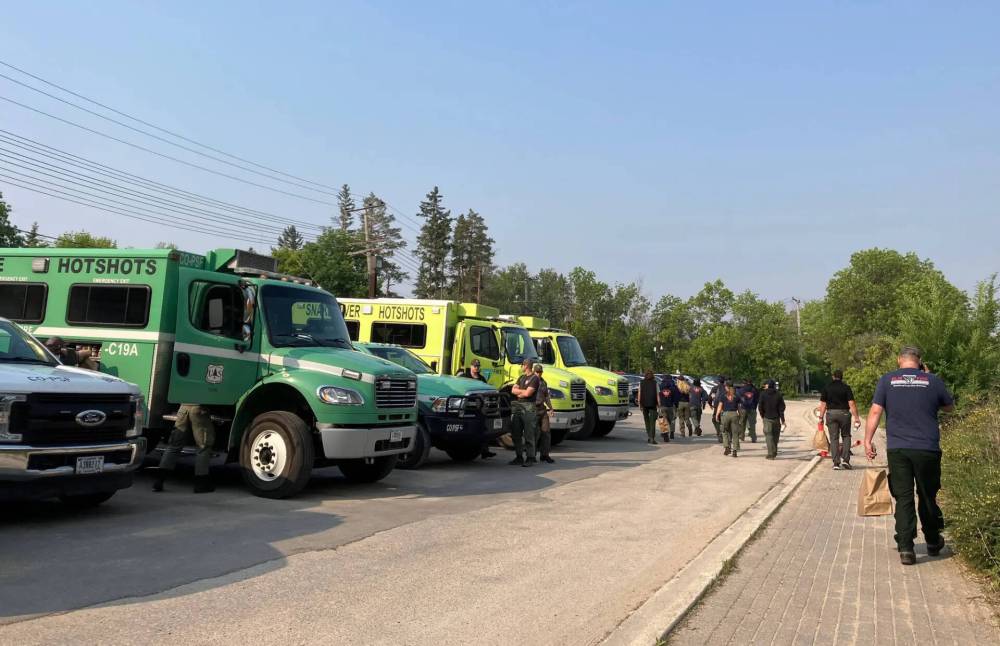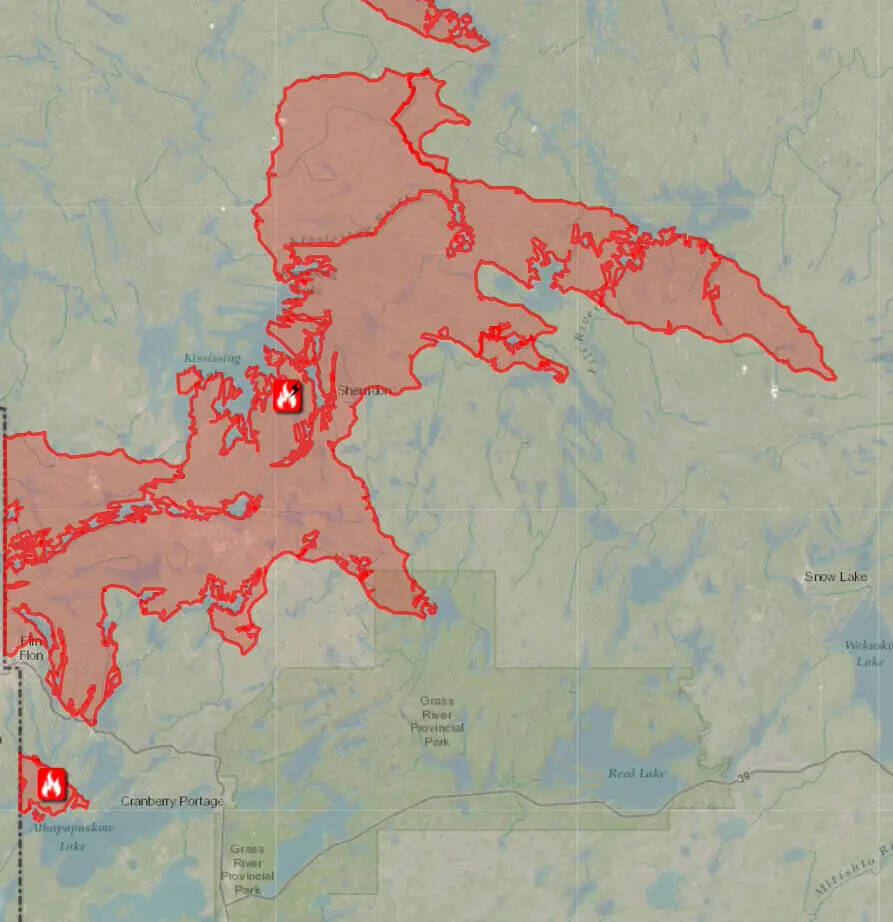Massive blaze reaches Flin Flon’s doorstep
Advertisement
Read this article for free:
or
Already have an account? Log in here »
We need your support!
Local journalism needs your support!
As we navigate through unprecedented times, our journalists are working harder than ever to bring you the latest local updates to keep you safe and informed.
Now, more than ever, we need your support.
Starting at $15.99 plus taxes every four weeks you can access your Brandon Sun online and full access to all content as it appears on our website.
Subscribe Nowor call circulation directly at (204) 727-0527.
Your pledge helps to ensure we provide the news that matters most to your community!
To continue reading, please subscribe:
Add Brandon Sun access to your Free Press subscription for only an additional
$1 for the first 4 weeks*
*Your next subscription payment will increase by $1.00 and you will be charged $20.00 plus GST for four weeks. After four weeks, your payment will increase to $24.00 plus GST every four weeks.
Read unlimited articles for free today:
or
Already have an account? Log in here »
WINNIPEG — Manitoba bolstered the front lines against northern wildfires Thursday to help protect communities — including Flin Flon, where two blazes merged to become one behemoth — while the number of evacuees climbed to more than 18,000.
A team of 260 firefighters was trying to hold back flames on the edge of Flin Flon and neighbouring Creighton, Sask., as crews from Parks Canada and the U.S. headed north to battle out-of-control wildfires.
“They’re doing everything they can to protect the actual perimeter of the city,” Flin Flon Mayor George Fontaine told the Free Press. “(The fire) is massive. It’s basically got a mind of its own.”

U.S. fire crews, in Manitoba to help with wildfires, prepare to leave the University of Manitoba in Winnipeg, Thursday morning. (Province of Manitoba)
The fire was more than 307,000 hectares on the Manitoba side of the provincial boundary — the largest in this province — after merging with a blaze near Sherridon.
No structures have been destroyed within Flin Flon’s limits, said Fontaine, an evacuee who is staying in Winnipeg after residents were forced to leave May 28.
An unknown number of buildings were destroyed outside of Flin Flon, said Kristin Hayward, assistant deputy minister for the Manitoba Wildfire Service.
She said officials were continually assessing risk and addressing areas of concern.
“When you have a very large fire there are a lot of potential ways it could go, so we really want to dial that down and look at specific key areas of concern based on the forecast and conditions,” Hayward said at a news conference.
Reinforcements were on their way to a blaze that threatened Pimicikamak Cree Nation and the incorporated community of Cross Lake.
The fire has jumped from island to island. Pimicikamak Chief David Monias said one island stood between the blaze and the evacuated communities.
“We’re hoping that they can hold it and it doesn’t go across,” he said.
Monias said up to 35 structural firefighters, six pumpers, water bombers and a command team were on their way to join 30 local firefighters and a combined 70 wildland firefighters from the province and the U.S.
Earlier this week, Monias and other First Nations leaders asked the provincial and federal governments to send more help to front lines.
“We’ve got quite a few (personnel) coming. This is what we needed,” Monias said. “They’re doing the same (protection) they did for Flin Flon.”
A separate fire, nearly 71,000 hectares, remained an active and significant threat to Lynn Lake, the town said in a statement.
In recent days, firefighters extinguished flames to prevent widespread damage and save Lynn Lake’s hospital in the evacuated town, the statement said. Some abandoned buildings were destroyed.
Hayward said cooler temperatures, higher humidity and low to moderate winds have helped crews make good progress on wildfires.
Officials expect those conditions to continue over the coming days. Predicted rainfall amounts this weekend are variable and uncertain.
“I’d like to remind Manitobans that just because you might see a blob of rain on that precipitation map, that’s not going to be enough to put out these fires,” Hayward said. “We will continue to be working on these fires for some time to come, but it certainly will help us to make good progress.”
Manitoba reported 27 active wildfires Thursday, with a seasonal total of 111. A dozen were out of control.
A provincewide state of emergency remained in effect.
Christine Stevens, assistant deputy minister for the Manitoba Emergency Management Organization, said 26 communities have evacuated and four are on short evacuation notice. Seniors or people with breathing or medical conditions voluntarily left some communities due to poor air quality from wildfire smoke.
More than 18,000 wildfire evacuees have registered with the Canadian Red Cross. Many evacuees have not registered because they are staying with family or friends, or they do not need supports, Stevens said.
A daily stipend for evacuees was set to begin Thursday.
Provincial policy aims to provide hotel rooms for all evacuees, said Lisa Naylor, the minister responsible for EMO.

A provincial map shows the extent of the fire near Flin Flon (at lower left) on Thursday. (Manitoba Conservation)
She said 1,732 hotel rooms in Manitoba were assigned to evacuees, with 200 still available and another 200 set to become available.
Evacuees have so far occupied almost 800 hotel rooms in Ontario in places such as Niagara Falls. The province has faced questions over the decision to send people out of province.
Naylor said Manitoba secured 1,500 hotel rooms in Ontario for evacuees, and was happy to accept an offer for rooms in that province. The offer in Ontario was presented “before we were able to mobilize as many rooms here in Manitoba” at the start of the crisis, she said.
When the largest evacuation period began May 28, with Flin Flon (about 5,000 residents), Pimicikamak (about 7,500) and other communities, Naylor said about 2,500 people from elsewhere had already evacuated, and Manitoba was hosting evacuees from northwestern Ontario.
Using the Emergency Measures Act to free up hotel rooms in Winnipeg is an option if required, but the ideal method is acquiring rooms “in a voluntary way,” she said.
The province launched a new website, called Manitoba Ready, which displays information about wildfires, supports for evacuees and congregate shelters in Winnipeg and other cities.
Naylor said about 359 people were in shelters as of Thursday morning. The figure changes daily as people arrive or are moved to hotels.
Natural Resources Minister Ian Bushie said Manitoba has deployed more than 650 people for firefighting efforts. More than 175 firefighters have joined from out of province.
“This is truly an all-hands-on-deck situation,” he said.
About 60 aircraft, including water bombers and helicopters with buckets, are involved.
About 100 firefighters and 25 managerial or support staff from the U.S. began making their way to front lines across Manitoba Thursday. About 110 additional firefighters are expected to arrive early next week.
Crews from Parks Canada and the U.S. were headed to the Rural Municipality of Kelsey, said Lori Forbes, the RM’s emergency co-ordinator.
Efforts were underway to protect structures in Cranberry Portage and Grass River Provincial Park. Cranberry Portage was evacuated for the second time in as many years due to wildfire.
The crisis renewed the Canadian Association of Fire Chiefs’ calls for the federal government to set up a national administrative body to help co-ordinate the response of municipal structural firefighters in future emergencies.
“Canada is the only G7 country that doesn’t have one,” said president Ken McMullen, the chief of emergency services in Red Deer, Alta.
A national body exists for Canada’s wildland firefighters, he noted.
McMullen said situations where wildland and structural firefighters have to work together to battle blazes that threaten both forested and urban areas are becoming more common.
» Winnipeg Free Press, with files from Maggie Macintosh
